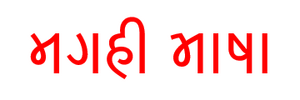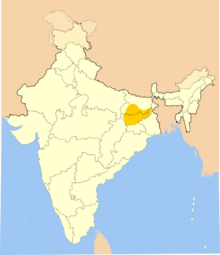Social:Magahi language
| Magahi | |
|---|---|
| Magadhi | |
| |
 Magahī Bhāṣā written in Kaithi script | |
| Native to | India |
| Region | Bihar [1][2][3] |
| Ethnicity | Magahi people |
Native speakers | 20.7 million (2011 census)[4][5] (additional speakers counted under Hindi) |
Indo-European
| |
Early form | |
| Dialects |
|
| Devanagari Kaithi(former) Gupta script(former) | |
| Official status | |
Official language in |
|
| Language codes | |
| ISO 639-1 | mag |
| ISO 639-3 | mag |
| Glottolog | maga1260[7] |
 Magahi speaking regions | |
The Magahi language, also known as Magadhi, is a language spoken in Bihar states of eastern India,[8][9] and in the Terai of Nepal.[10] Magadhi Prakrit was the ancestor of Magahi, from which the latter's name derives.[11]

It has a very rich and old tradition of folk songs and stories. It is spoken in nine districts of Bihar (Gaya, Patna, Jehanabad, Aurangabad, Nalanda, Sheikhpura, Nawada, Lakhisarai, Arwal), eight districts of Jharkhand (Hazaribag, Palamu, Chatra, Koderma, Jamtara, Bokaro, Dhanbad, Giridih) and in West Bengal's Malda district.[12] There are around 20,700,000 speakers of Magahi, including speakers of Khortha which is considered a dialect of Magahi.[4]
Magahi derived from the ancient Magadhi Prakrit, which was created in the ancient kingdom of Magadha, the core of which was the area south of the Ganges and east of Son River. It is believed to be the language spoken by Gautama Buddha to deliver sermons. It was the official language of the Mauryan court and Gupta Empire, in which the edicts of Ashoka were composed.
It is also known as Magahi which is directly derived from the name "Magadhi". It is also common in Magadh to refer to the region as Magah.
Though the number of speakers in Magahi is large about 12.6 million, it has not been constitutionally recognised in India. In Bihar, Hindi is the language used for educational and official matters.[13] Magahi was legally absorbed under Hindi in the 1961 Census.[14]
History
The ancestor of Magahi, Magadhi Prakrit, formed in the Indian subcontinent. These regions were part of the ancient kingdom of Magadha, the core of which was the area of Bihar south of the river Ganga.
The name Magahi is directly derived from the word Magadhi, and many educated speakers of Magahi prefer the name "Magadhi" over Magahi for the modern language.[15]
The development of the Magahi language into its current form is unknown. However, language scholars have concluded that Magahi along with Assamese, Bengali, Bhojpuri, Maithili and Oriya originated from the Magadhi Prakrit during the 8th to 11th centuries. These different but sister dialects differentiated themselves and took their own course of growth and development. But it is not certain when exactly it took place. It was probably such an unidentified period during which modern Indian languages begin to take modern shape. By the end of the 12th century, the development of Apabhramsa reached its climax. Gujarati, Marathi, Bengali, Assamese, Oriya, Maithili and other modern languages took definite shape in their literary writings in the beginning of the 14th century. The distinct shape of Magadhi can be seen in the Dohakosha written by Sarahapa and Kauhapa. Magadhi had a setback due to the transition period of Magadha administration.[16] Traditionally, strolling bards recite long epic poems in this dialect, and it was because of this that the word "Magadhi" came to mean "a bard". Devanagari is the most widely used script in present times, while Bengali and Odia scripts are also used in some regions and Magahi's old script Kaithi and Siddham script which were still widely used in the early twentieth century and during Gupta period respectively, is rarely used today. The pronunciation in Magahi is not as broad as in Maithili and there are a number of verbal forms for each person.[17] Historically, Magahi had no famous written literature. There are many popular songs throughout the area in which the language is spoken, and strolling bards recite various long epic poems which are known more or less over the whole of Northern India. In Magahi speaking area, folk singers sing a good number of ballads. Introduction of Urdu meant a setback to local languages as its Persian script was alien to local people.
The first success for spreading Hindi occurred in Bihar in 1881, when Hindi displaced Urdu as the official language of the province. After independence, Hindi was given the sole official status through the Bihar Official Language Act, 1950[18] ignoring the state's own languages.
Speakers of Magahi
There are several dialects of Magahi. It is spoken in the area which formed the core of the ancient kingdom of Magadha - the modern districts of Patna, Nalanda, Gaya, Jehanabad, Arwal, Aurangabad, Lakhisarai, Sheikhpura and Nawada and Munger. Magahi is bounded on the north by the various forms of Maithili spoken in Mithila across the Ganga. On the west it is bounded by the Bhojpuri, On the northeast it is bounded by Maithili and Angika. A blend of Magahi known as Khortha is spoken by non-tribal populace in North Chotanagpur division of Jharkhand which comprises districts of Bokaro, Chatra, Dhanbad, Giridih, Hazaribagh, Koderma and Ramgarh. People of Southern Bihar and Northern Jharkhand are mostly speakers of Magahi.[19] Magahi is also spoken in Malda district of West Bengal.[8][9] According to 2011 Census, there were approximately 20.7 million Magahi speakers.[5]
See also
- Culture of Magadh Region
- Culture of Bhojpuri Region
- Culture of Mithila Region
- Culture of Angika Region
- Pāli, the canonical language of Theravada Buddhism traditionally associated with the language of Magadhi
- Phool Bahadur
References
- ↑ Grierson, G.A.. "Magahi or Magadhi". https://archive.org/details/rosettaproject_mag_detail-1/mode/2up.
- ↑ "Magahi". https://www.omniglot.com/writing/magahi.htm.
- ↑ Atreya, Lata. "Magahi and Magadh: Language and the People". https://www.longdom.org/articles/magahi-and-magadh-language-and-people.pdf.
- ↑ 4.0 4.1 "Magahi". https://www.ethnologue.com/language/mag.
- ↑ 5.0 5.1 "Scheduled Languages in descending order of speaker's strength - 2011". Registrar General and Census Commissioner of India. 29 June 2018. http://www.censusindia.gov.in/2011Census/Language-2011/Statement-1.pdf.
- ↑ "झारखंड : रघुवर कैबिनेट से मगही, भोजपुरी, मैथिली व अंगिका को द्वितीय भाषा का दर्जा" (in hi). 21 March 2018. https://www.prabhatkhabar.com/news/ranchi/jharkhand-raghubar-das-cabinet-decision-maithili-bhojpuri-angika-magahi-second-language/1135878.html.
- ↑ Hammarström, Harald; Forkel, Robert; Haspelmath, Martin, eds (2017). "Magahi". Glottolog 3.0. Jena, Germany: Max Planck Institute for the Science of Human History. http://glottolog.org/resource/languoid/id/maga1260.
- ↑ 8.0 8.1 Prasad, Saryoo (2008). Magahī Phonology: A Descriptive Study. pp. 6. ISBN 9788180695254. https://books.google.com/books?id=p3N81Di9EN8C&q=magahi+people&pg=PA6. Retrieved 4 November 2018.
- ↑ 9.0 9.1 Brass, Paul R. (2005). Language, Religion and Politics in North India. pp. 93. ISBN 9780595343942. https://books.google.com/books?id=SylBHS8IJAUC&q=magahi+people&pg=PA91. Retrieved 4 November 2018.
- ↑ Eberhard, David M., ed (2021). Magahi (Twenty-fourth ed.). Dallas, Texas: SIL International. https://www.ethnologue.com/language/mag. Retrieved 29 April 2021.
- ↑ "How a Bihari lost his mother tongue to Hindi". 22 September 2017. http://www.livemint.com/Leisure/Nl73WC1JA8d6KVybBycNlM/How-a-Bihari-lost-his-mother-tongue-to-Hindi.html. It is considered as a dialect of Hindi continuum.
- ↑ Frawley, William (May 2003) (in en). International Encyclopedia of Linguistics: 4-Volume Set. Oxford University Press, USA. ISBN 9780195139778. https://books.google.com/books?id=sl_dDVctycgC&q=angika+in+west+bengal&pg=PA481. Retrieved 8 November 2018.
- ↑ "History of Indian Languages". Diehardindian.com. http://www.diehardindian.com/demogrph/moredemo/histlang.htm.
- ↑ Verma, Mahandra K. (2001). "Language Endangerment and Indian languages : An exploration and a critique". ISBN 9788120817654. https://books.google.com/books?id=tcfJY7kANo8C&q=awadhi+and+magahi+languages&pg=PA5.
- ↑ Jain Dhanesh, Cardona George, The Indo-Aryan Languages, pp449
- ↑ Maitra Asim, Magahi Culture, Cosmo Publications, New Delhi (1983), pp. 64
- ↑ "Maithili and Magahi". http://www.bihar.ws/info/Bihari-Languages/Maithili-and-Magahi.html.
- ↑ Brass Paul R., The Politics of India Since Independence, Cambridge University Press, pp. 183
- ↑ Verma, Sheela (2003). "Magahi". In Jain Dhanesh, Cardona George, The Indo-Aryan Languages. London: Routledge.
Further reading
- Munishwar Jha - "Magadhi And Its Formation," Calcutta Sanskrit College Research Series, 1967, 256 pp
- Saryu Prasad - "A Descriptive Study of Magahi Phonology", PhD thesis submitted to Patna University.
- A.C. Sinha (1966) - "Phonology and Morphology of a Magahi Dialect", PhD awarded by the University of Poona.(now Pune)
- G.A. Grierson Essays on Bihari Declension and Conjugation, Journal of the Asiatic Society of Bengal, vol. iii, pp. 119–159
- Hoernle, A.F. Rudolf & Grierson, G.A. A Comparative Dictionary of the Bihari Language
- Prasad, Swarnlata (1959) Juncture and Aitch in Magahi, Indian Linguistics, Turner Jubilee Volume, 1959 pp. 118–124.
- Sweta Sinha (2014) - "The Prosody of Stress and Rhythm in Magahi", PhD thesis submitted to Jawaharlal Nehru University, New Delhi.
- Sweta Sinha (2018)- "Magahi Prosody", Bahri Publications: New Delhi. Script error: No such module "CS1 identifiers"..
External links
- Magahi - A Historical language
- Jain Scriptures
- Magahi Detailed Description by Grierson, G.A.
- Magahī Phonology: A Descriptive Study by Saryoo Prasad
